Friday 8 January 2010
Sunday 13 December 2009
Evaluation
As we are creating a product in the style of a real media product we have only used the forms and conventions and have not challenged or developed them in anyway.
Framing of Interviews
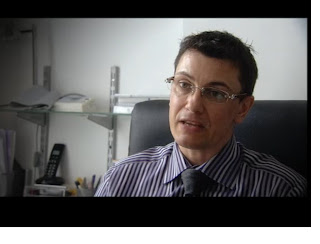
http://www.channel4.com/programmes/the-boy-who-was-born-a-girl/4od#3011207

Our product
Framing the shot is essential to creating a real media documentary. As you can see from the images above we have used the forms and conventions of a real media product. Our product is framed to the right looking slightly off to the left.This is the same of the Channel 4 documentary 'The Boy Who Was Born a Girl'. Our interviewee is represented as young and funky as she has been filmed in a bedroom this signifies our target audience and also we expect the audience to watch the documentary in a relaxed atmosphere. However the professional product is represented as formal but this is suitable for the target audience as the topic is serious.
Graphics
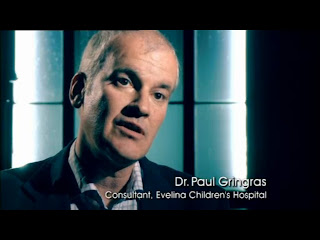
http://www.channel4.com/programmes/jess-britains-youngest-sleepwalker/4od#3011532

Our product
Graphics are essential to illustrate to the audience who is on screen. Similar to the Channel 4 documentary 'Jess: Britain's Youngest Sleepwalker' we have shown who the interviewee is and what their role is and their importance to the documentary. We used the colour purple throughout as this shows up on all backgrounds. Also it was the colour scheme that our audience questionnaire told us would be a suitable colour. As the technique of our documentary is Interview/'Talking Heads' it is important that we made it clear who each interviewee was so the viewer could understand how they contributed to the documentary.
Mise en scene
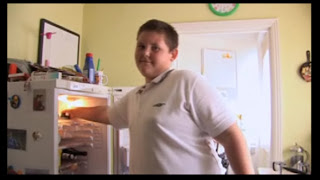
http://www.channel4.com/programmes/generation-xxl

Our product
Mise en scene is very important, everything in front of the camera illustrates to the viewer what is going on and what everything is about. Dark lighting may connote a gloomy topic and a bright lighting may signify a happy topic of conversation. My production uses natural lighting with shoes in the background to connote the topic of shoes. Where as the professional production uses natural lighting again but has a fridge as the main image in the background which links in with the topic of food and being obese.
Narrative Structure
We have used a linear structure throughout our documentary, taking you through different aspects of the shoe and the for and against individual styles.
Use of cutaways

http://www.channel4.com/programmes/octomom-me-and-my-14-kids/4od#3009375

Our product
Our product
Cutaways are important to the flow of the documentary. They are the key to the transition between shots. When Sadie is talking about her favourite shoe shop we use a cutaway of Schuh. In the documentary 'Octomum and my 14 kids' they use a cutaway of the mother and her children when talking about the topic of children. We use the forms and conventions of real media products as we use cutaways where and when necessary. Cutaways can also be used to disguise editing for example when the question is being asked. Cutaways can be used when a voice over is taking place above is an example of our product doing that. As our documentary is not a interactive documentary it important that the presence of camera and crew our not seen therefore cutaways are even more essential to disguise this.
Voice Over
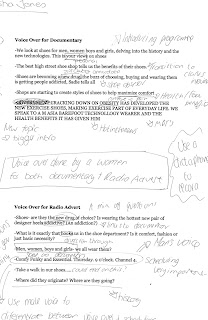
Using the codes and conventions of a real media product, we produced a script for both the documentary and the radio advert. We did not challenge or develop a real media product in any way. We used a selection of questions for the voice over to be used on the radio advert, using a selection of rhetorical questions is a convention of radio adverts. We created the questions based upon the script for the documentary. We used the idea of the shoe being a new addictive drug and followed this through in both voice overs to link them together. This is common in all real documentaries. As our documentary is a mix of expository and other styles it is essential that the 'voice of god' is used as this addresses the viewer.
Use of music
Use of Sound
Our documentary is made up of a mixture of diegetic and non-diegetic sound. The sound tracks used are all non-diegetic have been added in the editing process.
Use of archive material
Archive material is important as it is normally used as a cutaway. Using achieve material allows the documentary to appear more valid and reliable as it uses pre-existing material. We didn't use a lot of archive material as due to the subject it was hard to accumulate, however we did use the DVD footage that you receive when you buy a pair of MBT's as this was relevant to the topic of the interview.
2.How effective is the combination of your main product and ancillary tasks?
The radio advert and the documentary are effectively combined as we have used the same voice over in both which allows you to make the link. The voice over scripts for both the radio and the print advert are very similar including the same ideas but phrased slightly differently for each purpose. The radio advert is fun and upbeat which combines the target audience and the style of the documentary. Both ancillary tasks are closely linked, specifying the same scheduling and channel on each. The large image of the shoe made up of little shoes shows that the documentary has a selection of different aspects and not just the one topic as it includes sub-topics.
The print advert is for a newspaper only hence the landscape setup, however I do realise it could easily be used on a billboard if necessary. Our advert will be placed in specific newspapers to suit our audiences. This is them below:
We cant advertise on any of the BBC radio stations as these are only for BBC television programmes therefore we have chosen a range of national and commercial radio stations that are suitable for our target audience.. The stations we have used are widely accessible which allows for all viewers to be reached. Local stations will also be used in each area. (however these have not been listed) These are the main radio stations we will use below:
It is important to advertise our documentary as Channel 4 needs to ensure it gets viewers therefore being able to sell advertising space in advert breaks for them to make money to fund other programme productions.
Our Radio Advert will be scheduled for broadcast on weekdays at 7am-9am and 4pm-6pm as this is prime time. Our target auidence will be listening to the radio while preparing tea/breakfast, doing housework, on their way home to/from work and returning/going from shool with their children. It will also be played at weekends throughout the day to catch people on the move. The listeners can use the radio advert to seek information and also entertain them with the catchy song.
3.What have you learned from your audience feedback?
Pen Portrait
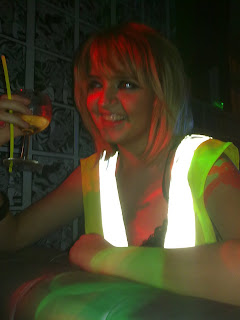
Name:Claire Walton
Age: 21
Occupation: Bank Assistant
Hobbies: Socialising with friends and shopping
Interests: Fashion and Politics
To collect our audience feedback we conducted a focus group, we played the documentary and radio advert to them and also allowed them to see the print advert. After all of the production was viewed we asked a variety of questions. Short videos are below of the main questions we asked. The focus group allowed us to make changes to the sound and the graphics used as this was the main weakness of our production.
We then went on to collate individual research from individuals to get a wider opinion on the production. We then sat down together and analysed these results and made changes appropriately. Below are also a few of the people we asked for feedback.
Our audience feedback is significant as it allows us to see that people would like to watch the documentary from listening to the advert, seeing the print advert and also just viewing the first five minutes. The main reason for this that the editing was suitable for our target audience as it kept it fun and funky as well as educating about topics linking in with shoes.
Another point was the sound levels were inconsistent we went on to alter these as best we could but due to the lack of us using a microphone on all interviews this was hard to do so. We did not use a microphone with Rev R Swindell and Lisa Kenny. We did not use a microphone for Rev R Swindell as facilities were not available, the reason Lisa Kenny interview was not conducted using a microphone was on the arrival of the filming the microphone was not working. Sadie Harding Jones interview we did use a microphone however she was holding it to low and when asked to hold it closer to her mouth she did for a few seconds then returned to previous position. I realise the importance of using a microphone as it allows the sound quality to be even throughout. If I had time to repeat aspects of the production this would be the main one, I would ensure a microphone is used at all times as this affected the quality greatly.
The audience feedback confirmed our channel and scheduling time and date for the documentary, people said it would be suitable and some added that it could even be earlier as not harsh topics are discussed. We decided not to change the scheduling time as after researching into Channel 4 we realised the majority of the documentaries were scheduled at 9pm which is the same as ours. We do realise however topics discussed in other Channel 4 documentaries may not be suitable for before the watershed, whereas the first five minutes of ours would be suitable for viewing before the watershed.
I learnt that all the content was well linked together and when topic changes were made they were obvious but in a subtle manner. We were also informed that all products were well combined making it easy for the viewer to make a link between them all even if viewed on different occasions.
Audience Feedback is hugely significant to the production of a documentary as it allows the producers to know whether the intended target audience would like to watch it therefore if it would be successful or not. Media Organisations always conduct a focus group to test the product they have produced whether is be a new TV programme or a new magazine to decided on what changes need to be made for it to be more successful and if it is suitable for them. Normally the focus group is picked at random and normally money is offered for them to participate in the group.
4.How did you use technology?

The technology aspect was hugely important to the production of all the products as well as the construction, research, planning and evaluating. Throughout I used a selection of technical devices such as; video camera, still camera and Dictaphone. I also used a selection of professional software; Adobe Photoshop, Adobe Premiere, Adobe Audition and Windows Movie Maker. I also used the Internet for research and planning and the school's professional radio suite was used to record the radio advert. I ensured I used a variety of technologies to ensure the final product looked realistic and professional.
Still Camera
This was essential to be used in the production as it allowed us to keep photograph evidence of the progress of the production and it also allowed us in the audience feedback to photograph our focus groups for our evaluation.
Video Camera
Without this our documentary would not of been filmed. We used it for all our filming for the documentary and we also used it in the audience feedback for our evaluation.
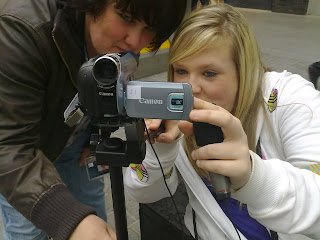
Tripod
This was essential to keep a steady and clear shot when filming. We used a tripod for all of the filming as this improved the standard and professionally of the production.

Microphone
Although this was not used on all the interviews, we ensured it was in use on recording all the voxpops and the majority of interviews. By using a microphone the sound quality was a better standard making the over all production a better standard.
Internet
I used this mainly for the researching and planning of the production as it allowed us to find the history of the shoe and shoe shops with ease. I have also used the Internet to present my work throughout by using an online blog. The online blog allows me to publish word documents, video files and picture files following the progress in my work.
Camera Phone
I used my phone to take pictures on several occasions, on one occasion the memory card was full on the still camera therefore we had to use a phone to take pictures. I also used my phone to record answers the the audience research using both the video and voice recorder settings. I then went on to record phone conversations we made arranging interviews using the recording setting whilst on the phone.
Dictaphone
I used this to record my own voice to include in my evaluation. I also used the dictaphone to record answers for both the reserach and the evlauation. The dictaphone came in really handy as it was small and lightweight so could be used anywere we needed to use it.
Windows Movie Maker
I used this package for my evaluation as it allowed me to make short movies simply. I also used it to add sound clips as I was unable to upload sound clips onto the blog.
Adobe Photoshop
This was used for the print advert. The use of layers was very convinent as the main image was made up of loads of shoes which had to be done on individual layers. We also used this to design the graphics for the documentary
Adobe Audition
This was used to edit down song tracks for the documentary. It was also used to produce the radio advert as different sound bites could be collated together.
Adobe Preimere Pro
This package was used to edit the whole documentary as it had tools that allowed us to add graphics, and import the filming easily.
Scanner
I used this to scan storyboards, magazine articles, edit decision list and tape log sheets. Having a scanner in school and at home made it easy for me to scan work to upload onto my blog.
Ice Radio Suite
This is the professional radio suit we have in our school. We used this to record the scheduling for the radio advert.
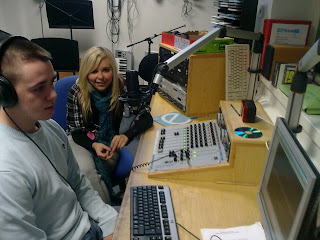
Computer
As the production was computer based alot of my work took place on a PC, I used packages that were included in windows such as Windows Excel to produce graphs for the auidence research, Windows Word to type up the running order and any research I found out. Without a computer accesible at all times it would have been hard to keep on top of tasks.
DVD Player
This was mainly used to watch exsiting documentaries when I was researching into the codes and conventions of exsiting products. I also used it to chose what footage I wanted from the MBT DVD we used as archieve material.
New media technologies have developed greatly over time having an impact on us therfore allowing us to experiment with them to produce for ever changing products. New technologies have been very helpful in our production of our documentary as without them the product would not of been as higher quality that I hope that we have produced it to. It has developed into smaller and lighter equipment making following someone less intrusive.
Interactive documentaries are very rare today but this is due to the new technologies that allow producers to not include the camera and crew in the recordings. Without the development in new technologies this may still be a regularly used method.
Tuesday 8 December 2009
Permission Letters
To: humanresources@sonymusic.com
From: Sasha Jones
Dear Sony Music Records,
We would like to use the following songs in a documentary we are producing for our A Level coursework:
Paolo Nutini- New Shoes
Footloose soundtrack
Elvis Presley blue suede shoes
We will not allow any other resources to use your music tracks in any way, we will not edit them in any way and will only use them in our documentary.
We would really appreciate it if you would give us permission to use your songs
Yours Sincerely
Sasha Jones, Natalie Allcock, Whitney Griffiths
As some of our participants were under sixteen we asked their parents/guardians if they would give permission. This is a blank copy of the letter we produced for both theirs and our records:
Dear Parent/ Guardian,
As part of my A-Level Media coursework I am producing 5 minutes of a documentary. For all under 16’s I need permission on behalf of them from their parent or guardian.
I would really appreciate it if you could fill in the slip below to allow me to feature them in the documentary.
The documentary will not be broadcasted and will be kept confidential.
Yours Sincerely
Sasha Jones, Natalie Allcock and Whitney Griffiths
-------------------------------------------------------------------
I give permission for…………………………………….. to feature in the documentary ‘Comfy Funky and Essential’
Signed…………………………………(parent/guardian) Date…………………………............
Edit Decision Lists
We created an edit decision list before starting to edit. We all had a copy so when editing individually we were all able to do so. After all the footage was recorded we sat down together with the logging sheet and the running order and completed the decision list. This came in really handy as we knew exactly what was coming next on the timeline.
Edit Decision List 1

Edit Decision List 2
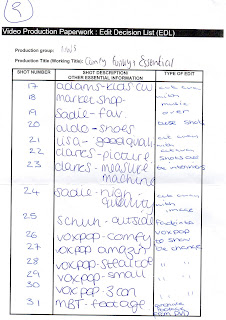
Edit Decision List 3

Sunday 6 December 2009
Voice Over Scripts
Voice Over for Documentary
-We look at shoes for men, women boys and girls, delving into the history and the new technologies. This is your views on shoes
-The best high street shoe shop tells us the benefits of their shoes.
-Shoes are becoming a new drug, the buzz of choosing, buying and wearing them is getting people addicted, Sadie tells all
-Shops are starting to create styles of shoes to help maximize comfort
-GOVERNMENT CRACKING DOWN ON OBESITY HAS DEVELOPED THE NEW EXERCISE SHOES, MAKING EXERCISE PART OF EVERYDAY LIFE. WE SPEAK TO A M ASIA BAREFOOT TECHNOLOGY WEARER AND THE HEALTH BENEFITS IT HAS GIVEN HIM
Voice Over for Radio Advert
-Shoes- are they the new drug of choice? Is wearing the hottest new pair of designer heels addictive? (An addiction?)
-What is it exactly that hooks us in the shoe department? Is it comfort, fashion or just basic necessity?
-Men, women, boys and girls - we all wear them?
-Comfy Funky and Essential. Thursday. 9 0'clock. Channel 4.
-Take a walk in our shoes.....
-Where did they originate? Where are they going?



